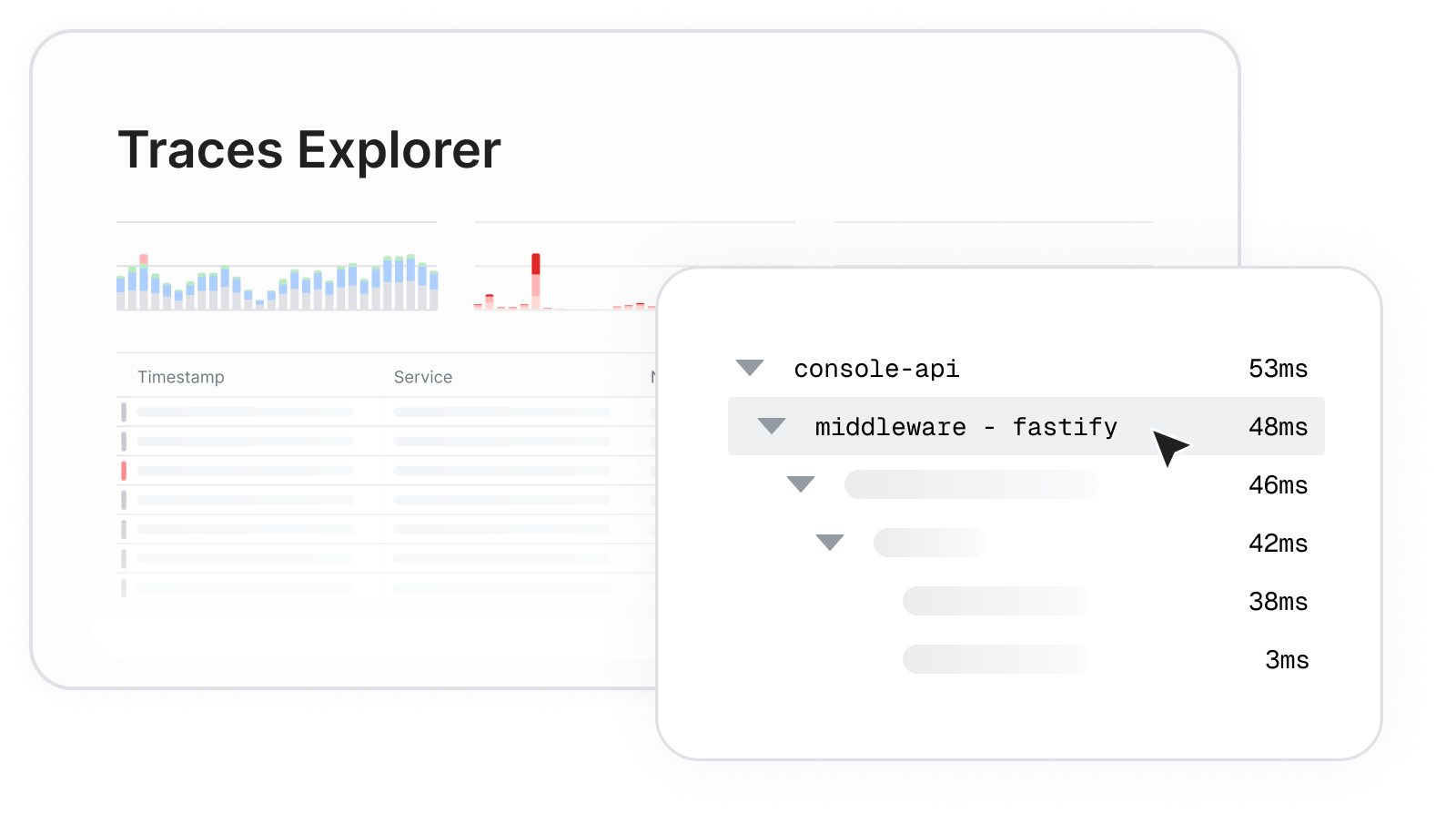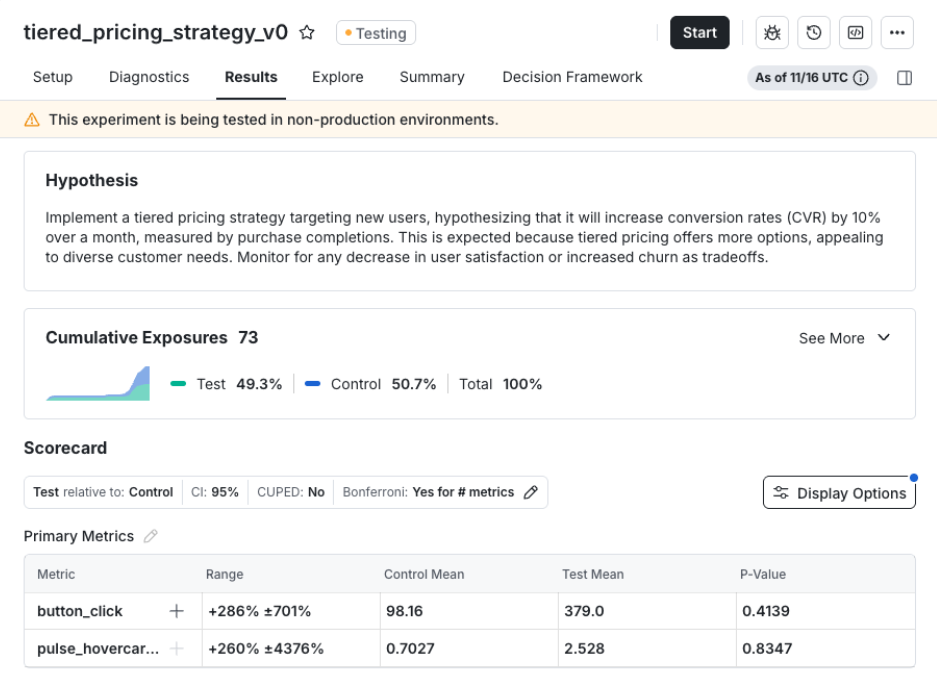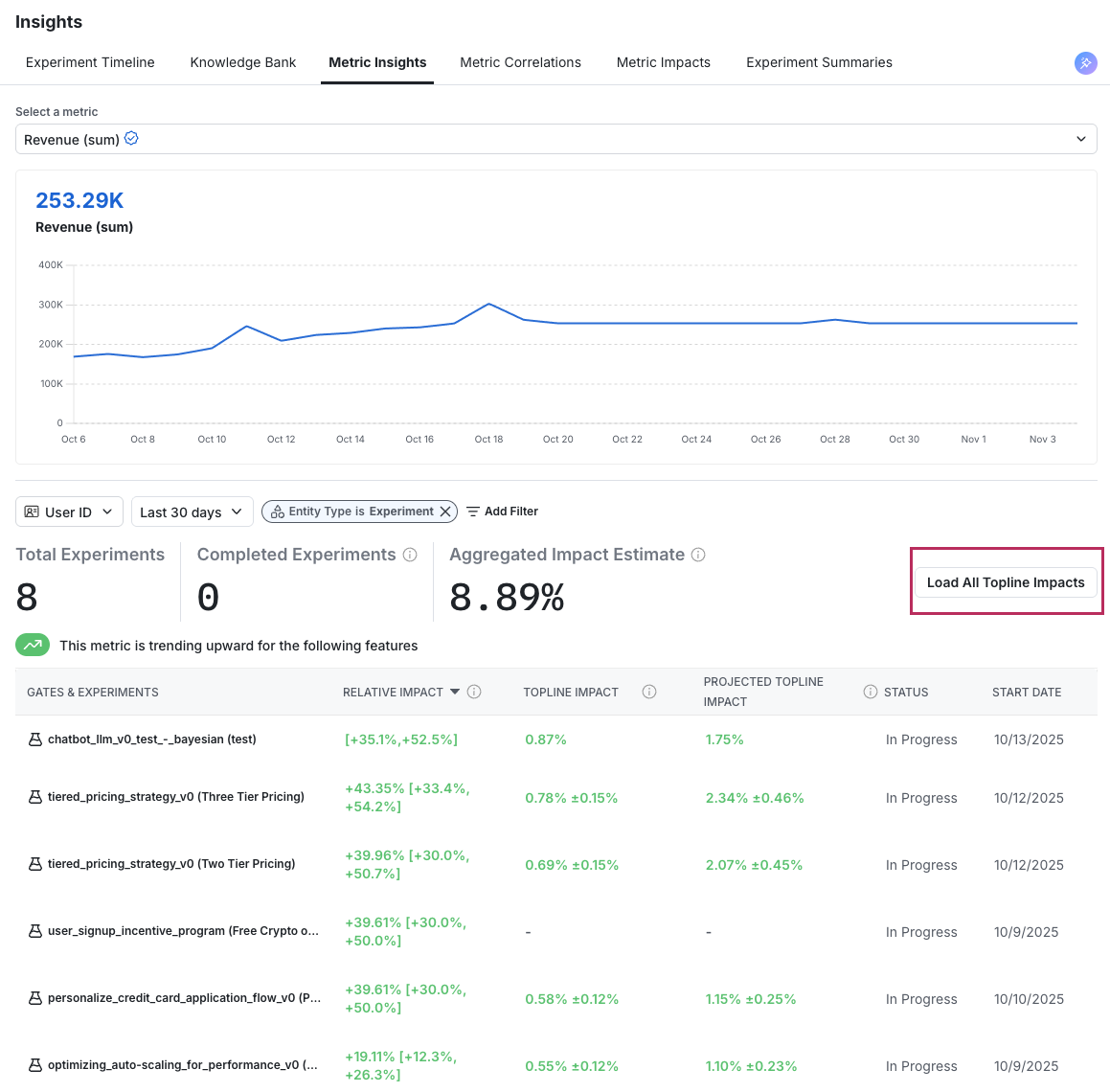Product Updates
Nov 2025
Oct 2025
- 🪵 Console Logs in Session Replay + Activity Pane Revamp
- 🧮 Sum Property Values at Funnel Conversion
- ⏰ Schedule Experiment Start
- 💪 Power Analysis Enhancements
- 🔎 Warehouse Events
- 🚪Feature Gate Exposures in Metrics Explorer
- 👨⚕️ Docs v2
- 📈 Autocapture Updates
- 📝 Statsig Visual Editor
- 💰 Rich Text Widgets on Dashboards
Sep 2025
- 📈 Change Alerts
- 🧪 Exposure Imbalance / Sample Ratio Mismatch (SRM) Debugging in Metrics Explorer
- ✍️ Custom Chart Annotations in Drilldown
- 🔍 Conversion Drivers in Funnels on WHN
- 🚢 Custom Experiment Decision Framework
- ✅ Personal Console API Key
- 🎶 API Endpoints for archiving and unarchiving Dynamic Configs
- 🧪 Sampling Across All Charts
Aug 2025
Jul 2025
Jun 2025
- 🔄 Automatic Dashboard Refreshes
- 🧪 Experiment Exposure Events Metrics Explorer
- 🎯 Conditional Recording Triggers for Session Replay
- 👁️🗨️ Chart Annotations
- 🕵️♂️ Log Explorer
- 📉 Fieller Interval
- 🧙🏻♂️ AI Onboarding Wizard
- 🛫 Pulumi Statsig Provider
- 📊 Data Table View in Metric Drilldown
- 🌩️ Statsig MCP Server
- 📸 Results Snapshot
- 🪨 Geotest Experiments
May 2025
- 🧮 Unique Values Aggregation
- 📈 Delta Comparison View for Time Series
- 🧑🏼🏭 Braze Integration
- 🚢 Experiment Decision Framework
- 📝 Setup Page's New Layout
- 🗂️ Multiple Group-Bys in Funnels
- 📐 Format Y-Axis Units in Time Series Charts
- 📋 Copy Experiment Metrics
- 🕒 Compute Scheduling
- 📊 Experiment Histograms
- 🖥️ Warehouse & Compute Mappings
Apr 2025
- 🚨 Topline Alerts Enhancements
- 🔮 Surrogate Metrics
- 📊 Compare more Groups in Funnels
- 🍩 Donut Chart & World Map 🌍
- 🎯 Cohort Filters on Dashboards
- 📊 New Aggregation: Count per User
- 🧭 User Journeys on Warehouse Native
- ✋ Holdout Analysis in Product Analytics
- ⚙️ New Chart Options in Metrics Explorer
- 💉 CURE (CUPED vNext)
- 📜 Helm Charts for Forward Proxy
Mar 2025
Feb 2025
Jan 2025
- ⚙️ Custom Metrics in Funnels
- 👤 User Profiles
- 📊 Distribution Charts++
- 🐍 Python Server Core
- 🕵Differential Impact Detection
- 💾 Results in your Warehouse
- ☕️ Java Server Core
- ⚔️ Interaction Detection
- ⚙️ Improved Console Settings
- Slicing by frequently used user properties
- Debug Data Ingestion Errors
- 👥 Filtering by User Dimensions in Custom Metrics
Dec 2024
Nov 2024
Oct 2024
- 🎉 SCIM User Provisioning
- 📋 Dynamic Configs Now Have Templates!
- ⏱️WHN Compute Transparency
- ⚡Inline Power Analysis
- 🔍 Focused Analysis with Top Group Limits
- 🥇 First-Value metrics
- 🪵🪄 Log transforms
- ⌚💰📊 Latest value metrics
- 👯 Cohort analysis in all charts types
- 🧲 Group-by in Retention Analysis
- 📊 Cohort Analysis in Funnels
- ⏱️ 2x Funnel Performance Improvements
- 🔗 Improved Segment Integration
- 🪜Funnels Now Support Up to 15 Steps
- 💥 Cross-Environment Feature Gates View
- 🚫 Metrics Update: Deprecating event_dau metric
Sep 2024
Aug 2024
- 🎛️ Dashboard Filters
- 🧠 Experiment Knowledge Base
- 🎓 Meta Analysis : August Release
- 📧 Dashboard PDF Export
- 🚀❤️📊 Statsig <3 Funnels
- 📅 Expanded Chart Granularities and MAU support
- 🧲 Retention Overhaul
- ✨🛤️✨User Journeys Overhaul
- 🕒 Session Analytics Private Beta
- 📋 Custom Experiment Checklist
- 📈 WHN Product Analytics
- 🤖 Bot Filtering
- 🤳 Parameter Stores
Jul 2024
- 📊 Benjamini-Hochberg
- 🔗 Combine Events in Funnel Steps
- 🌊 Session Streams
- 🔍 First-Time Filters in Funnels
- ⌨️ Keyboard Navigation
- 💾 Reusable Cohorts
- 📊 Outlier Detection
- 🧢 Capped Metrics (WHN)
- 🕵 Differential Impact Detection
- 💄 New look and feel on Statsig
- 👩💻 Statsig Managed API Proxy
- 🏠 New Home Experience
- 🧮 Improved Formula Support
- 🙋♀️ User Management v2
- 🎓 Meta Analysis : July release
Jun 2024
May 2024
🔐 OAuth Support for Statsig MCP Server
We’ve upgraded authentication for the Statsig MCP Server to support OAuth — supplementing the previous key-based authentication flow. This brings a more secure, scalable, and standards-aligned approach to connecting your MCP tooling with Statsig.
Why this matters
OAuth makes it easier and safer for teams to integrate the Statsig MCP Server with their development workflows and in more tools. It enables clearer permission boundaries, smoother onboarding and persistent sessions, and better alignment with modern enterprise security practices.
Getting started
Follow the updated setup instructions in our docs to enable OAuth for your MCP Server connection. No changes are required to your existing Statsig feature flags or experimentation setup — just update your authentication method to take advantage of the new flow.
Learn more in the docs here: https://docs.statsig.com/integrations/mcp
🕵 Traces Explorer now in Beta
Traces show how a single request moves through your system, one step at a time. Statsig new lets you explore those spans alongside experiments and feature rollouts.
Traces Explorer = faster root cause. You no longer need to jump between tools to understand slow or failing requests. Statsig brings traces, logs, metrics, and alerting into one place for critical launches.
Bring observability into your product decision loop.
Traces Explorer (Beta) is available for Cloud customers. View trace setup instructions here.

🔌 Reverse Power
What is Reverse Power?
It shows the smallest effect size your test had power to detect based on actual sample size and standard error of the control group (it does not depend on the observed effect size of the experiment). It’s a great tool to leverage retrospectively near the end of an experiment to make more informed decisions.

How is it used?
Helps you reflect on what your experiment actually could detect
Helps you with iteration decisions like extending the experiment, rerunning with greater sample, or re-evaluating the experiment design
Getting started
Toggle it on/off anytime in Settings → Product Configuration → Experimentation. To learn more about Reverse Power see our docs here.
🕳️ Results in Lower Environment
For our Cloud users, we’ve added support for viewing cumulative exposure and metric results for experiments enabled in lower environments. Helping users catch issues early and ship experiments with confidence.

This makes it easier to verify that:
Users are being bucketed correctly
Your metrics are logging as expected
To enable this, go to the experiment setup page, select Enable for Environments, run tests in your lower environment, and view real exposure and metric data before launching to production.
For more information on the new lower environment testing features see the docs here.
🧏♀️ Recent Queries in Logs Explorer
Debugging usually means retracing your steps. You try something, flip tabs, run a new search, and then can’t remember the exact query that actually pointed you in the right direction. It breaks your flow and slows everything down.
Recent Queries fixes that. Logs Explorer now shows your last five searches right in the search menu. No more digging through tabs or guessing what you ran before. Jump back into earlier investigation paths, compare results in seconds, and pick up your workflow without losing momentum.
A small change with a big payoff for staying in the zone.
🍋 Metric Source Freshness
Statsig WHN users can now quickly check the freshness of their Experiment Metrics Source data directly from the experiment results page. The data displays the most recent timestamp found in a Metric Source during results computation, helping users identify potential issues in their data pipeline that could delay results calculation.

🚨 Topline Alerts on Metrics
Topline Alerts work best when they track the exact metric your team relies on. Until now, Topline Alerts could only be created using events, which meant rebuilding the metric logic each time. This increases the potential of duplicated definitions, drift over time, and confusion about what the “real” definition should be defined as.
This update fixes that. You can now create Topline Alerts using existing metrics in your Metrics Catalog. The alert uses the metric’s definition exactly as it is, so everything stays consistent and aligned. No rewriting. No re-creating logic. No guessing which version is correct.
It keeps your metrics clean, keeps ownership clear, and removes the risk of definitions drifting as teams grow.
🧾 Experiment Results Table View
Today we're excited to announce Table View for experiment results. It's perfect for users who want to examine their experiment results in greater detail while keeping everything consolidated in a single view.
With Table View, users can now see Control Mean, Test Mean, and P-value—in addition to the data points available in the default cumulative view.

🏡 Metric Family
Managing a large metric catalog can be challenging—especially when many metrics are slight variants of a single source metric. Ensuring that updates to the main metric cascade correctly to all of its variants can be difficult and error-prone.
For our WHN customers, we’re excited to introduce Metric Families. Users can now create Child Metrics (variants) from a Parent Metric, ensuring that any changes to the Parent automatically flow down to its Children. This makes it easier to manage large catalogs while giving teams the flexibility to create and maintain metric variants without losing consistency.
The feature is available for Sum and Count metric types. Follow this link to learn more.

📚 Bulk Topline Impact Calculation
Many users want to understand how the metric changes measured in their experiment translate to shifts in the overall metric (topline impact) or project the expected impact if the variant were rolled out to the broader population (projected topline impact).
For our WHN customers, calculating Topline impact just got easier with the launch of our bulk upload feature. Users can now update this data centrally from the Experiment Insights Page, making it easier than ever to measure the aggregate impact of experiments on key business metrics.

Loved by customers at every stage of growth















